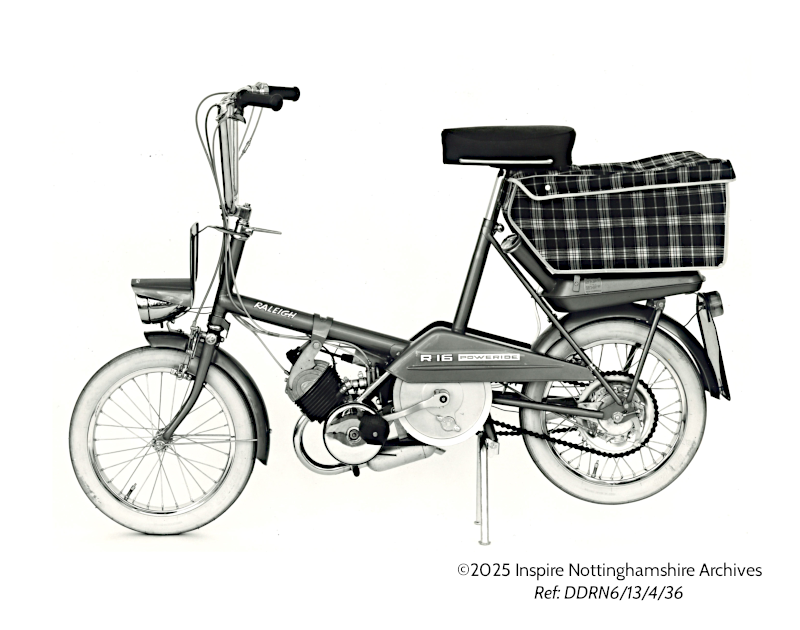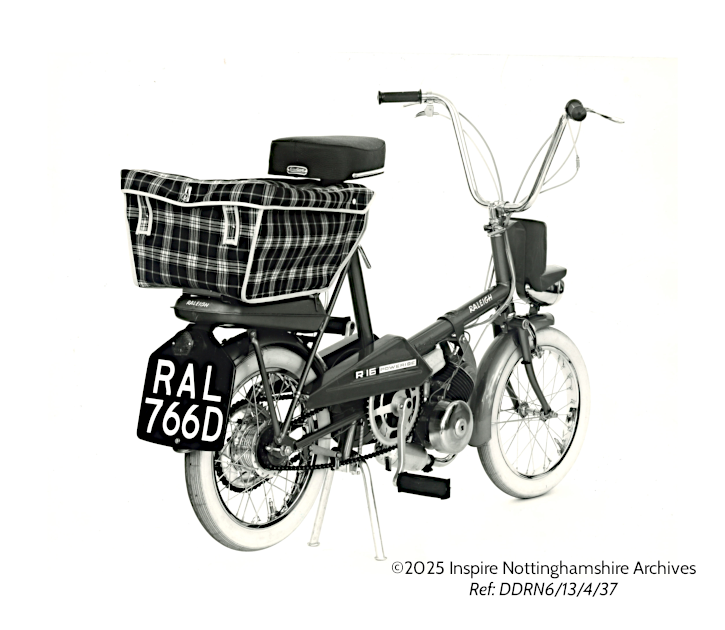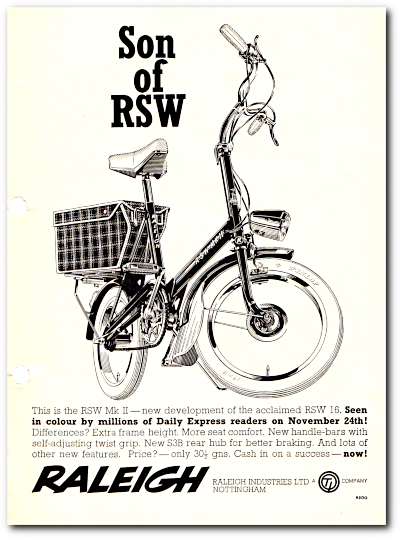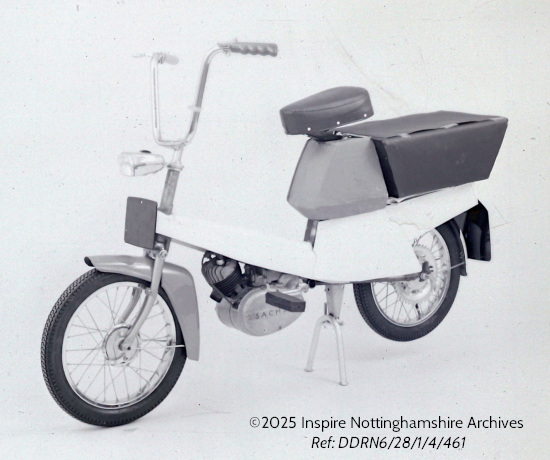Even before the introduction of the RSW16, somebody at Raleigh had also come up with the idea of motorising this forthcoming small-wheel bicycle by fitting the Motobécane engine that was already being licensed in the contract of 5 October 1960.
The project to produce a motorised version of the small-wheel bicycle was coded RM7, and we can get some idea when this started because the engine specification was entered as 1.4bhp, as taken from the early continuous-fin, 6.5:1 compression motor used in the RM6 at the time, and up to November 1965 when the early engine would be wholly succeeded by the new replacement split-fin 7.5:1 compression, 1.7bhp engine.
The RM7 code would have been allocated to the motorised RSW16 project before, or at the same time as, the RM8 Automatic MkII project was issued. The RM7 model however, required somewhat more involved development than the simple RM8 Automatic MkII, which was announced and introduced in December 1963, so the RM7 project must also have been commissioned at latest sometime in 1963. A Raleigh Small Wheel 16 pre-production bicycle model was only shown to Alex Moulton (as a patent check) as early as 1964, to go on sale in 1965 as the RSW16.
It’s easy to presume that the RM7 may have simply involved bolting an engine into the RSW16 cycle frame, but the physical mechanics don’t quite work like that. While the RM7 looked very similar to the bicycle, it actually employed a completely different frame with reinforced sections at all its joints.
The earliest ‘D’-registered factory prototype RM7s were completed and running around on pre-production road tests from summer 1966 (JAU 70D), and early ‘E’-registered examples (after August 1966), at which time the models were already branded by a Wisp graphic.
While we were at Nottingham Inspire in June 2024 researching for our article on ‘The Ghost’, we incidentally came across a few other lost images from the Raleigh Company Archives that nobody knew anything about…

RAL 766D might appear to be a 1966 Nottinghamshire issued registration, except that this number isn’t real! AL-serials were issued by Nottinghamshire Authority, but they never used the RAL nnnD series. Maybe the RAL letters were chosen just because it’s a Raleigh? We can only speculate whether 766 might mean the model was made (or the picture was taken) in July 66? Otherwise it seems an odd number to choose.
While the R16-Poweride seems to be largely based on the RSW16 cycle frame, it is also equipped with quite a number of clearly Wisp components, which suggests it was built as a parallel project in the early development phase.
Items that are recognisable as Wisp include the dimpled 36-hole rear wheel with 44T rear sprocket, pedal chain-wheel, and headlamp. Since the RSW16 frame has a longer headstock stem, the ‘Wisp pattern’ handlebars might appear to have been set in the lowest position, but that handlebar clamp doesn’t look like the one-piece Wisp set.

After we trawled an investigation through all the Raleigh cycle handlebars, the closest match would seem to be the bar-set from the obscure Raleigh Mustang. The Mustang seems to be a copy of American bikes like the Schwinn Stingray; this catalogue is undated but the Mustang was launched at the 1966 Earls Court Show. The Mustang seems to be an almost ‘forgotten bike’, and its presence in the Raleigh range would appear to alter the usual accounts of the history of the Raleigh Chopper.
R16’s round stand bracket looks to be one from an RM4 or 5, since it’s certainly not the Wisp style channel stand bracket. The RSW16 frame carried a light-weight cycle side-stand that wasn’t capable of supporting the bike when fitted with an engine, so Raleigh had to fit a centre stand to make it stable.
The engine is an early 1.4bhp continuous-fin engine, though oddly fitted with a later type low-tension mag-set!
We don’t feel the headlamp position on the front mudguard would have been legal for a moped in the UK, because it’s mounted too low.
The Giuliari saddle is of Italian origin, and we don’t think that this was fitted on any other Raleigh machines.
The R16 has a ‘fixed’ pedal chain tensioner; Wisp was fitted with a ‘sprung’ pedal chain tensioner.
The HT coil mounting bracket is pop riveted to the frame, which looks like an improvised ‘last minute’ R&D job on a marketing model, and doesn’t seem like it would have been a production standard finish.


The ‘R16-Poweride’ is clearly a prototype model that failed to win approval. It’s as though it’s intended to present a lower cost alternative to the Wisp, but when you look at the few actual ‘cost reduced’ parts like the calliper front brake compared to the RSW16 front hub, and the fuel tank (which supports the rear bag without need for the rear carrier), fitment of cheaper 2.125 cycle grade tyres, omitting the chrome engine trims, and RSW16 nylon bush in the top steering head instead of the Wisp top bearing race … it’d be easy to conclude that there might not be enough cost-saving to make a worthwhile difference in listing both the Wisp and the R16 competing with it.
A MkII version of the RSW16 bicycle was announced on 1 September 1967, and would be presented at the Earls Court Show later that month.
The MkII was a cost reduced version of the original RSW16, as a result of Raleigh acquiring Moulton on 7 August that year, then pitching the Moulton & cost reduced RSW MkII at different markets rather than being competing models.
Introduced 14 April 1967, Wisp production officially ended in September 1969, but at some point within this period Raleigh’s marketing department may have been looking to update the design toward a Wisp Mk2 …
… maybe something like this?

The headlamp on the Wisp Mk2 looks like the same headlamp as on the RSW16 MkII, so we’d presume this would date the Wisp Mk2 model to around late 1967–68 for this headlamp to be available.
The Sachs 1.6–2.0ps motor is an unexpected fitment and, since it seems to be based on a Wisp frame, why didn’t they simply leave the Motobécane engine fitted? Sachs did manufacture automatic ‘Saxonette’ versions of its motor, and maybe Raleigh Marketing was thinking to progress, beyond the belt drive flywheel, to a ‘unit’ automatic engine?
We presume the ‘light grey shape’ beneath the saddle was representing what was intended to be the fuel tank, with the white frame panels presumed to be possible body trim pressings or plastic mouldings, and the black box behind the seat an integral rear carrier.
The front mudguard looks as if it’s adapted from the Autocrat prototype, but now with cut-outs to enable fitting between the narrower Wisp forks.
The negative was titled as ‘Wisp Mk2 mock-up’, so maybe little more than an initial marketing impression model with superficial rear body panels, though it could demonstrate the lines along which they were thinking of further developing the Wisp.


Raleigh previously fitted Sachs engines in the Eire Raleigh Super, and seemingly bought later stocks of these engines from Sachs. This would probably be a follow-on from Norman having a spares agency agreement with Sachs.
The original Principal (contract) Agreement between Raleigh and Motobecane dated 5th October 1960 is covered by a Supplemental dated 11th April 1961, which includes ‘Option for Raleigh to renew contract’ Item 14. If three years before the expiration of the Principal Agreement, if Raleigh so request, Motobecane will continue the contract for a further twelve years.
I'd have to review the entire Principal Agreement to find what the original term agreement was, but it wouldn't seem relevant considering a twelve year extension was left on the table at Raleigh’s request…
Regards
Danny.
I've looked it up…
The original contact period was just over twelve years; it expired on 31 December 1972. There was the option to extend it by a further five years with at least one year″s notice. Then, as Danny says, the supplemental agreement changed the extension to 12 years with at least three years’ notice.
I assume the Sachs engine was something that happened to be handy and doesn’t mean Raleigh wanted to look elsewhere for an engine; the bike is just a mock-up with bodywork that looks like cardboard. The engine is more of a ‘placeholder’ for something different.
Maybe Raleigh wanted something a bit ‘cleaner’ and more modern looking than the 1950s’ style of the belt & pulley? However, it’s hard to think what they could have got from Motobécane that was like that. Motobécane did have the Solex Ténor’s engine, but not until 1974; and there was also the D55 engine, but that was 1974 too. Perhaps Raleigh hadn’t thought that far ahead either.
Andrew